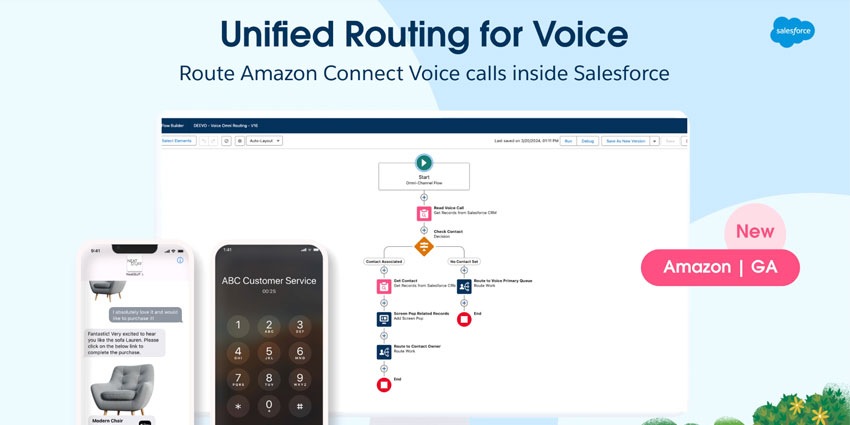Salesforce offers powerful CRM technology. For this reason, it leads the market, outselling its nearest competitor four to one – according to the IDC.
Now, the vendor is creeping further into the CCaaS space, with contact centers increasingly leaning on Service Cloud.
With native channels, case management tools, and AI-powered workflows, the platform allows contact centers to run more of their operations through the CRM.
In addition, in times of an economic slowdown, many operations are eager to converge their systems, work with fewer vendors, and streamline their spending.
Maybe this is why 2022 Metrigy research found that 55 percent of IT and CX leaders think CRM solutions will replace contact center platforms “within five years”.
Yet, there are significant barriers that CRM providers must break through first, with voice perhaps the most pressing.
A Powerful Tool, But Voice Is Still a Concern
The statistic above seemingly suggests that contact center providers are at risk of obsolescence. Yet, Robin Gareiss, CEO of Metrigy, doesn’t see it that way.
Commenting on the study, she stated: “I don’t think it will go that far because voice will never go away as a customer interaction channel – and voice is really hard to do well.
“Though, CRM providers have started offering voice on their own or through partnerships, they simply aren’t as reliable or advanced as contact center providers.”
Indeed, delivering voice infrastructures that are reliable and scalable is no small feat. Because of this, Five9 CEO, Mike Burkland, stated during a recent earnings call:
“A lot of folks believe they can enter the [CCaaS] space very quickly, and it takes them a lot longer than they anticipate.”
Moreover, many mid-market and enterprise contact centers already have significant complexity embedded in their voice architecture. As a result, they have become rooted in the technology of their current contact center platform providers.
Faced with these challenges, Salesforce has somewhat of a mountain to climb before its starts to challenge CCaaS market leaders – despite the release of Service Cloud Voice.
Additionally, those contact centers that have already deployed this – or added a telephony integration to Service Cloud – have uncovered teething issues regarding voice.
Here is an example of a struggle they may face.
When the Voice Workflows Just Don’t Flow
Despite its powerful process capabilities, the simple telephony integration Salesforce offers can’t match up – according to Pierce Buckley, CEO & Co-Founder of babelforce.
“Many service operations have found this problematic,” he says. “After all, if a telephony integration does not allow routing tools to dynamically look up custom objects during the IVR in Salesforce, make a clever decision, and do something about it – that can cost the business a lot of money.”
As an example of this, say the customer indicates they are looking to cancel, many operations will pull them into a shorter queue to increase the chance of retention.
Buckley delves deeper into this issue in the video below.
Phone Integration Problems with Salesforce from babelforce GmbH on Vimeo.
For now, such use cases require integrations with Service Cloud. Without these, the contact center could drop customer lifetime value dramatically.
Moreover, this is only one example highlighting the problem of creating processes between telephony, and the CRM in Service Cloud.
As such, many businesses with relatively simple requirements still turn to large-scale CCaaS providers to provide a telephony integration, run the routing, agent desktop and more.
The result is that contact centers cannot extract full value from the robust Service Cloud solution on which it has spent lots of money.
So, What Is the Solution?
babelforce offers a no-code process automation creator between voice and what happens in Salesforce – allowing businesses to build the processes that work for them.
The solution – babelConnect – also solves quality and reliability issues regarding audio calls, allowing businesses to get maximum benefits from an already significant investment.
In addition, a team of contact center experts deploys the solution, offering white-glove service.
Given that the consultants that help implement Service Cloud are still mostly CRM experts, this is helpful – as teams may maximize the efficiency of contact center processes inside Salesforce.
Indeed, those that have already deployed Service Cloud may still have no shortcuts between applications or idle customs fields – which agents don’t need to fill – taking up valuable real estate.
Such issues take up agents’ cognitive energy, add to handling times, and cost lots of money across a large operation.
babelforce helps its clients overcome these problems, while babelConnect acts as the glue that binds the telephony and CRM.
In doing so, the solution allows contact centers to gain full value from Service Cloud, including all of Salesforce’s latest Einstein AI innovations, which run through it.
A Roadmap to the Future
If the 55 percent of IT and CX leaders that believe CRM solutions will take over the contact center within five years are correct, many more businesses will likely move to Salesforce Cloud.
Yet, until Salesforce fleshes out its voice proposition, most will likely continue to press ahead with a telephony integration.
Contact centers must be wary of working with particular CCaaS providers for this, which put forward calling plans, take hold of their numbers and SIP trunks, and make it harder for them to migrate.
When this happens, the future CX ambitions of many businesses – which orient around Service Cloud Voice – may fall apart.
babelforce helps its clients avoid this issue, deploying numbers globally, securing their voice proposition, and supporting their future roadmap.
To learn more about the contact center specialist and its babelConnect solution, visit: www.babelforce.com







